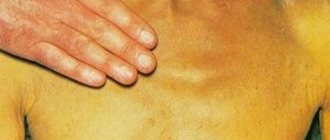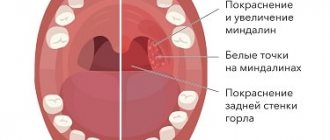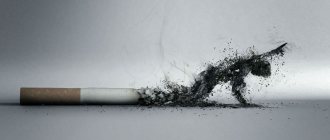A chemical skin burn is a violation of the integrity of the skin resulting from exposure to chemicals. The danger of this type of injury is due to the ability of chemical agents to react with tissues, damaging them. The rehabilitation process is complicated by the fact that the effect of the aggressive substance can continue even after the removal of the damaging component. Let's take a closer look at when you can treat chemical burns at home, and when you need to seek medical help.
Classification
Burns are classified based on the extent, location and type of injury.
Degree
The degree of burn is determined by the extent of the damage (area and depth):
- IV - characterized by necrosis of dermal cells and global damage to subcutaneous structures - epidermis, papillary and reticular layers of the dermis. The area of damage at this stage also extends to muscle tissue, ligaments, joints, and subcutaneous fat.
- III - divided into two groups. “A” - the dermis is partially affected, when the epithelial elements (glands and hair follicles) remain intact. “B” - manifested by damage to all layers of the epidermis and dermis. Tissue death can occur after several hours or days.
- II - partial damage to the keratinized layers of the epidermis and epithelium.
- I degree is the least dangerous stage of a chemical burn. The upper layer of the epidermis is damaged.
Localization
The degree of resistance and strength of protective functions of the skin can have different indicators. Thus, the skin of the face, neck, internal parts of the body and mucous membranes are more vulnerable . Burns in these areas are more dangerous and more difficult to treat.
Type
By type of injury, chemical burns are classified depending on the active substance.
- Acids. When exposed to skin, a coagulating effect is characteristic - blood clotting when blood vessels are damaged. This causes relatively shallow penetration of the damaging substance. The higher the concentration of acids, the shallower the depth of the damage, since the dynamics of the appearance of a scab (a protective crust formed from blood, pus, dead tissue covering the wound) is higher. All types of acids, both organic and inorganic, including hydrochloric and sulfuric acid, can act as a damaging substance.
- Alkalis. The reaction with dermoid tissue occurs faster in alkali burns. Unlike acids, alkalis cause a burn by dissolving and emulsifying skin cells. The affected area is wider, since the substance inhibits recovery processes. The most common alkalis are: sodium hydroxide, potassium hydroxide, calcium hydroxide, calcium oxide, ammonium hydroxide.
- Phenol. Upon contact with the skin, the substance is rapidly absorbed and causes deep tissue damage. Phenols include benzoic acid derivatives and phenolic alcohols.
- Fluorine. Hydrofluoric or hydrofluoric acid has the property of instant transdermal absorption.
- Phosphorus. As a lipotropic substance, phosphorus is characterized by rapid absorption into the blood. In addition to burns, it causes intoxication of the body, affecting the cardiovascular and central nervous systems.
- Salts of heavy metals. Most often, such substances leave a superficial wound.
Symptoms
Depending on the scale of the damaged area and the degree of the burn, the victim’s symptoms vary from severe pain to painful shock.
- A first-degree burn is accompanied by a characteristic burning sensation, redness of the skin, and slight swelling of the tissue. The wound looks like a thermal burn.
- In the second degree of damage, redness and blisters appear.
- The main sign of a third-degree burn is the formation of a blistering cover with serous-hemorrhagic contents.
- The most difficult stage is the fourth degree. Most often, with such an injury, pain shock occurs.
There are seven clinical forms of burns:
- Wet necrosis. A large amount of dead tissue with abundant fluid content is prone to bacterial growth at the site of injury.
- Dry necrosis. Drying dead tissue.
- Erythema. Redness of the damaged area, accompanied by swelling.
- Vesicle. Formation of blisters at the burn site.
- Bulla. Merging of several bubbles.
- Erosion. The surface of the skin, devoid of the top layer.
- Ulcer. An area of skin with deep damage to the layers.
First aid
At the first aid stage, you must adhere to strict rules, taking into account the degree of the burn, its location and cause.
- First you need to eliminate the influence of the provoking factor . If boiling water or a chemical gets on your clothing, you must immediately remove it from the damaged area. In case of electric shock, eliminate its source (unplug the device from the outlet).
- In case of thermal damage, it is necessary to immediately cool the burned surface with running cool water, but not extremely cold or ice, since a sharp temperature contrast will worsen the condition of the tissues. Keep under running water or apply cold compresses for a long time - up to half an hour for a 2nd degree burn.
- If the cause of the pathology is a chemical compound, after washing with clean water, it should be neutralized with a substance of the opposite structure: if affected by an acid, treat the surface with a soda solution, if exposed to an alkali, rinse with a solution of citric acid. Quicklime must not be washed off with water!
- In case of severe burns (third or fourth degree), with the formation of a wound surface, the burn cannot be treated with water or chemical compounds to avoid infection. In this case, you need to apply an antiseptic, for example, Chlorhexidine, to the edges of the wound and cover the affected area with sterile wipes. Such injuries cannot be treated with alcohol-containing products, as they increase pain.
- In case of severe pain, anesthesia is required . You can take the analgesic in tablet form. In medical institutions, parenteral methods of administering non-narcotic or even narcotic analgesics are practiced.
- All jewelry must be removed from the injured limb and placed in an elevated position in order to avoid the development of severe swelling.
What to do first
The quality of treatment for chemical burns largely depends on the timeliness of first aid and appropriate pre-medical diagnosis.
You can use your palm to roughly measure the area. It makes up 0.80-1.5% of the total surface of the skin. Conventionally, a first-degree burn (regardless of area) and a second-degree burn (no more than 5% of the skin is affected) are considered light. First aid for chemical burns involves removing the damaging substance as quickly as possible. To do this, you need to know what caused the injury and choose the right antidote - a substance that can neutralize the aggressive reagent.
If the chemical gets on the mucous membranes, esophagus or eyes, you must urgently call an ambulance!
First aid algorithm
Chemical burns can have serious consequences, including suffocation, so when taking emergency measures you need to follow certain rules:
- Determine the nature of the substance that caused the injury.
- Remove any remaining reagent by thoroughly rinsing it with running water. Rinse the damaged area for at least 10 minutes. It is important to remember that not all chemical burns can be treated with water.
- Injuries caused by acid are washed with a one percent soda solution. Then you need to apply a bandage with a solution of ammonia.
- An injury resulting from contact with the skin of alkaline compounds must not be washed with water . A solution of acetic or citric acid neutralizes the reagent.
- If liquid nitrogen comes into contact with the skin, rinse the wound thoroughly with water.
- In order to neutralize quicklime, the affected area is treated with fat.
- Phosphorus reagents have the property of spontaneous combustion. To protect against this process during a phosphorus burn, the damaged area must be completely immersed in water.
- A burn caused by phenol is treated with alcohol solutions or vodka.
- After complete treatment of the wound with neutralizing agents, apply a dry sterile bandage.
- Painkillers will help avoid painful shock.
- Drinking plenty of fluids is necessary to protect the body from dehydration and partially neutralize the effects of chemicals in the blood.
Signs and characteristics of chemical burns
Symptoms appear immediately after exposure to chemical components and may become more severe over time. Signs depend on the degree and location of the lesion and on what kind of acid gets on the skin or mucous membranes:
- When exposed to sulfuric acid, the surface turns white and then acquires a gray tint. If contact lasts for a long time, a brown scab will form;
- Nitric acid promotes the formation of a yellow-green or brown-yellow scab;
- Salt is characterized by a yellow tint to damaged tissues;
- When exposed to acetic acid, a dark brown crust forms.
Symptoms appear immediately and may become more severe over time.
Acid burns usually cause less harm because the dangerous component rarely affects deep cells. The situation is different with alkalis. They penetrate much deeper into the tissue, causing the damage area to become wider. If a chemical reagent gets on the skin or mucous membranes, there is a risk that it will continue to be absorbed into the cells even after rinsing with water. Therefore, the diagnosis and extent of damage can be clarified only a week after the injury occurs.
Drug treatment
The specialist prescribes medications for subsequent treatment at home. Most often, for skin lesions caused by chemicals, the following drugs are indicated:
- Fusiderm . External application in the form of ointment, cream or gel. The active ingredient is fusidic acid. Additional components: wax, mineral oil, alcohol, petroleum jelly. Has an antiseptic effect. Prevents the growth of bacteria on damaged skin areas. Promotes wound healing.
- Panthenol. The active substance is pantothenic acid. The drug accelerates epithelization and scarring of skin lesions. The presence of vitamins and polyunsaturated fatty acids in the medicine helps restore skin cells.
- Drugs that help stimulate regenerative processes.
Prevention
In most cases, chemical burns can be avoided; it is only important to follow the rules:
If it is necessary to work with aggressive substances, use protective clothing and goggles.- Train personnel in safety precautions.
- It is imperative to use bright, visible markings to indicate caustic drugs not only at work, but also at home.
- Store all household chemicals, pesticides, as well as batteries, solvents, adhesives and even nail polish remover out of the reach of children.
- Work with household chemicals and solutions only with gloves, having first studied the instructions on the packaging.
- Do not pour aggressive substances into bottles and jars of cosmetics, medications, or worse, food.
- Do not place plants at home whose properties have not been studied.
Chemical burns leave behind, at best, severe pain and an unpleasant experience, and at worst, serious consequences in the form of non-healing wounds, loss of vision, and serious damage to internal organs. Therefore, if you suspect a chemical burn, you must immediately contact a specialist - a surgeon (for skin damage), an ophthalmologist (for eye damage), a gastroenterologist, a toxicologist (for damage to internal organs).
Chumachenko Olga, doctor, medical observer
8, total, today
( 193 votes, average: 4.55 out of 5)
Formaldehyde poisoning: symptoms and treatment
Respiratory failure: classification and emergency care
Related Posts
Alternative medicine
Folk remedies for chemical burns are allowed to be used only during the recovery period.
Useful recipes:
- Chamomile, hops, and oak bark have good antiseptic and anti-inflammatory effects . Compresses from plant decoctions promote rapid healing of damaged skin areas. To make a decoction, you will need 1 teaspoon of herbal tea per 0.5 liters of water. The mixture is brewed in a water bath for 15 minutes.
- A medicinal ointment based on aloe leaves helps relieve pain, moisturize and nourish the skin. Proportion of the healing agent: 50 g of plant pulp per 50 g of honey. Apply the ointment to the affected area, previously treated with hydrogen peroxide or a weak saline solution.
- Potatoes are known for their antiseptic properties. For first and second degree burns, a paste of raw root vegetables is used and applied to the wound.
- Cabbage leaves. The high content of vitamins A, B, C in this vegetable helps to increase the regenerative abilities of the skin. For burns, you can use whole cabbage leaves or make a paste. Cabbage juice is also very useful. To alleviate the condition, apply a compress, changing it every half hour.
- Beeswax based ointment is very effective in treating burns . Ingredients: vegetable oil, egg yolk, beeswax. All ingredients must be in equal proportions. The composition should be smeared on the damaged area after treatment with hydrogen peroxide.
- Sea buckthorn oil. The drug is rich in vitamins and microelements that promote wound healing. It is often prescribed as part of complex therapy, along with the general course of treatment. It is necessary to apply sea buckthorn oil to a cotton napkin and apply it to the damaged area. The compress needs to be changed every 3 hours.
- Carrots have a high regenerative effect, due to the high content of tocopherol and vitamin A. The ground root vegetable can be mixed with egg yolk and used as an ointment to treat burns.
Taking bioactive supplements and vitamin complexes will improve the regenerative abilities of tissues. Home care for the victim should be carried out subject to the recommendations of specialists.











